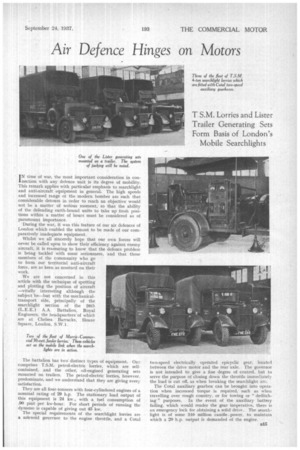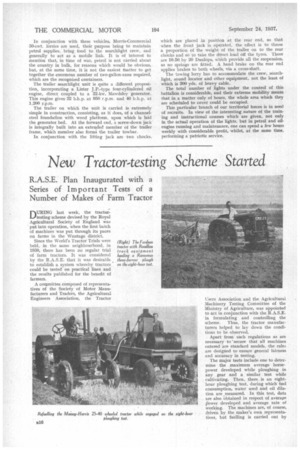Air Defence Hinges on Motors
Page 49

Page 50

If you've noticed an error in this article please click here to report it so we can fix it.
T.S.M. Lorries and Lister Trailer Generating Sets Form Basis of London's Mobile Searchlights
IN time of war, the most important consideration in conlnection with any defence unit is its degree of mobility. This remark applies with particular emphasis to searchlight and anti-aircraft equipment in general. The high speeds and increased range of the modern bomber are such that considerable detours in order to reach an objective would not be a matter of serious moment, so that the ability of the defending earth-bound units to take up fresh positions within a matter of hours must be considered as of paramount importance.
During the war, it was this feature of our air defences of London which enabled the utmost to be made of our comparatively inadequate equipment.
Whilst we all sincerely hope that our own forces will never be called upon to show their efficiency against enemy aircraft, it is reassuring to know that the defence problem is being tackled with some seriousness, and that those members of the community who go to form our territorial anti-aircraft force, are as keen as mustard on their work, We are not concerned in this article with the technique of spotting and plotting the position of aircraft —vitally interesting although the subject be—but with the 'mechanicaltransport side, principally of the searchlight section of the 26th (L.E.E.) A.A. Battalion, Royal Engineers, the headquarters of which are at Chelsea Barracks, Sloane Square, London, S.W.I.
The battalion has two' distinct types of equipment. On comprises T.S.M. petrol-electric lorries, which are selfcontained, and the other, oil-engined generating sets mounted on trailers. The petrol-electric lorries, however. predominate, and we understand that they are giving every satisfaction.
They are all four-tonners with four-cylindered engines of a nominal rating of 29 h.p. The stationary load output of this equipment is 24 kw., with a fuel consumption of .90 pint per kw-hour. For short periods of running the dynamo is capable of giving out 45 kw.
The special requirements of the searchlight lorries are a solenoid governor to the engine throttle, and a Cotal two-speed electrically operated epicyclic gear, located between the drive motor and the rear axle. The governor is not intended to give a fine degree of control, but to serve the purpose of closing down the throttle immediately the load is cut off, as when breaking the searchlight arc.
The Cotal auxiliary gearbox can be brought into operation when increased torque is required, such as when travelling over rough country, or for towing or deditching " purposes. In the event of the auxiliary battery failing, which would render the gear inoperative, there is an emergency lock for obtaining a solid drive. The searchlight is of some 210 million candle .power, to maintain which a 20 h.p. output is demanded of the engine. In conjunction with these vehicles, Morris-Commercial 30-cwt. lorries are used, their purpose being to maintain petrol supplies, bring food to the searchlight crew, and generally to act as a mobile link. It is of interest to mention that, in time of war, petrol is not carried about the country in bulk, for reasons which would be obvious, but, at the same time, it is not the easiest inatter to get together the enormous number of two-gallon 'cans required, which are the recognized containers.
The trailer searchlight unit is quite a different proposition, incorporating a Lister J.P.-type four-cylindered oil engine, direct coupled to a 22-kw. Mawdsley generator. This engine gives 32 b.h.p. at 950 r.p.m. and 40 b.h.p. at 1,200 r.p.m.
The trailer on which the unit is carried is extremely simple in construction, consisting, as it does, of a channelsteel foundation with wood platform, upon which is laid the generator bed. At the forward end, a screw-down jack is integrally built into an extended member of the trailer frame, which member also forms the trailer towbar.
In conjunction with the lifting jack are two chocks. which are placed in position at the rear end, so that when the front jack is operated, the effect is to throw a proportion of the weight of the trailer on to the rear chocks and so to take the direct load of the tyres. These are 10.50. by 20 Dunlops, which provide all the suspension, as no springs are fitted. A hand brake on the rear end applies brakes to both wheels, via a cross-shaft. The towing lorry has to accommodate the crew, searchlight, sound locator and other equipment, not the least of which is 300 yds. of heavy cable. The total number of lights under the control of this battalion is considerable, and their extreme mobility means that in a matter only of hours, the whole area which they are scheduled to cover could be occupied.
This particular branch of our territorial forces is in need of recruits. In view of the interesting nature of the training and instructional courses which are given, not only in the actual operation of the lights, but in petrol and oilengine running and maintenance, one can spend a few hours weekly with considerable profit, whilst, at the same time. performing a patriotic service.




























































































